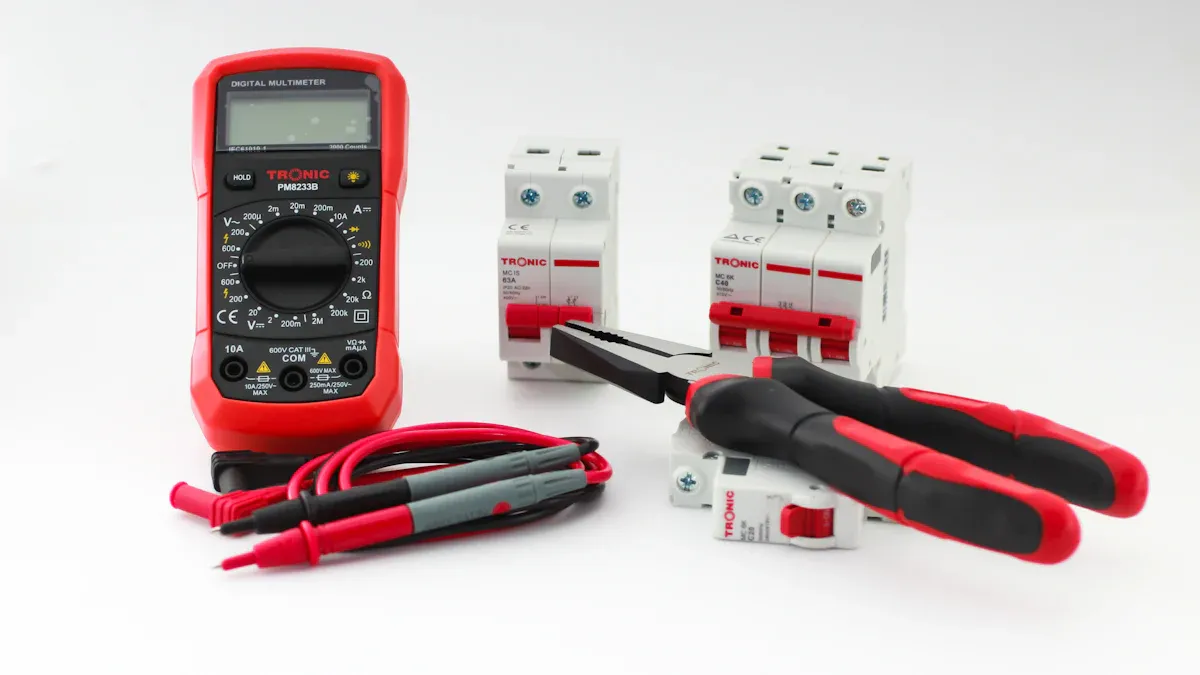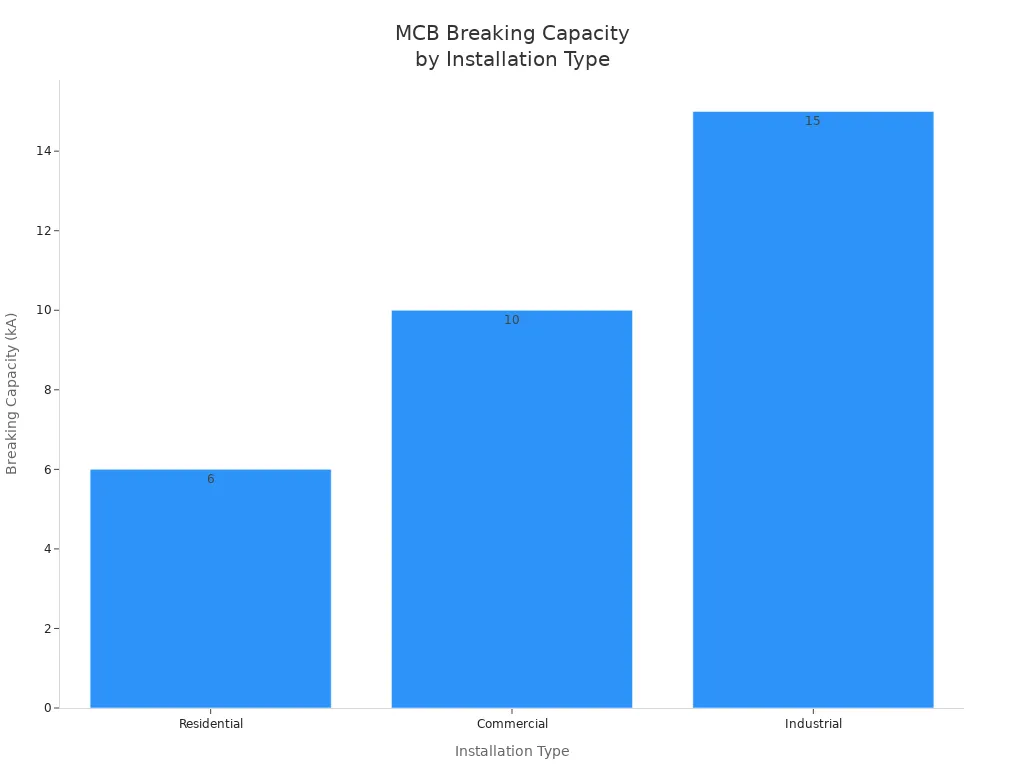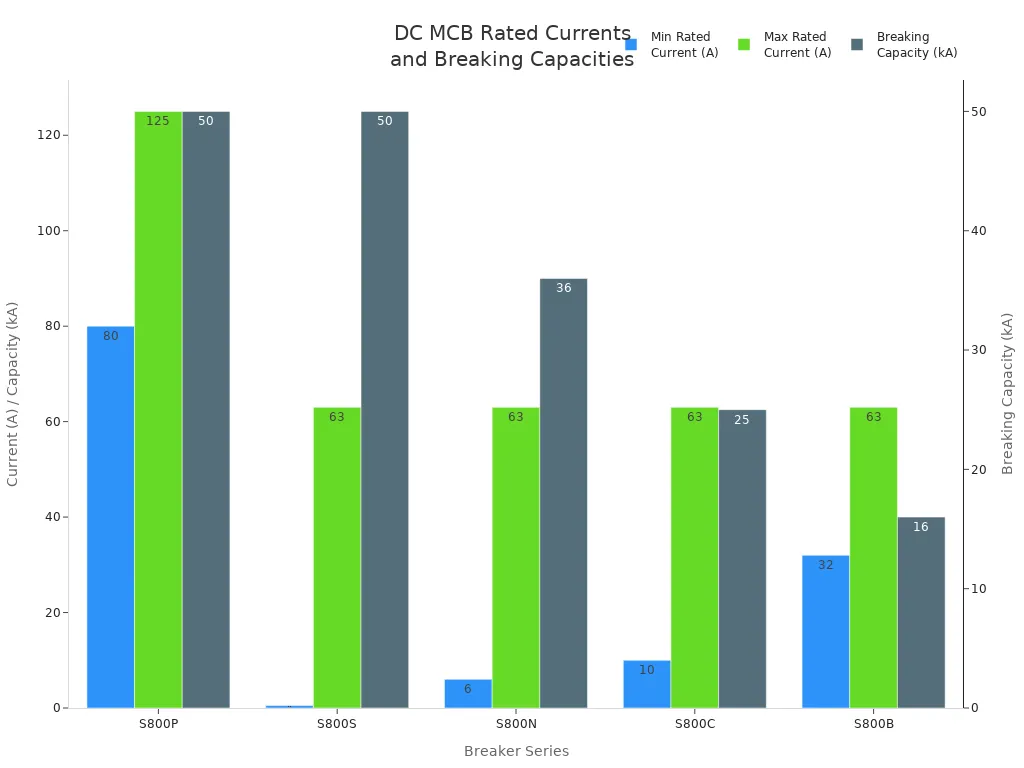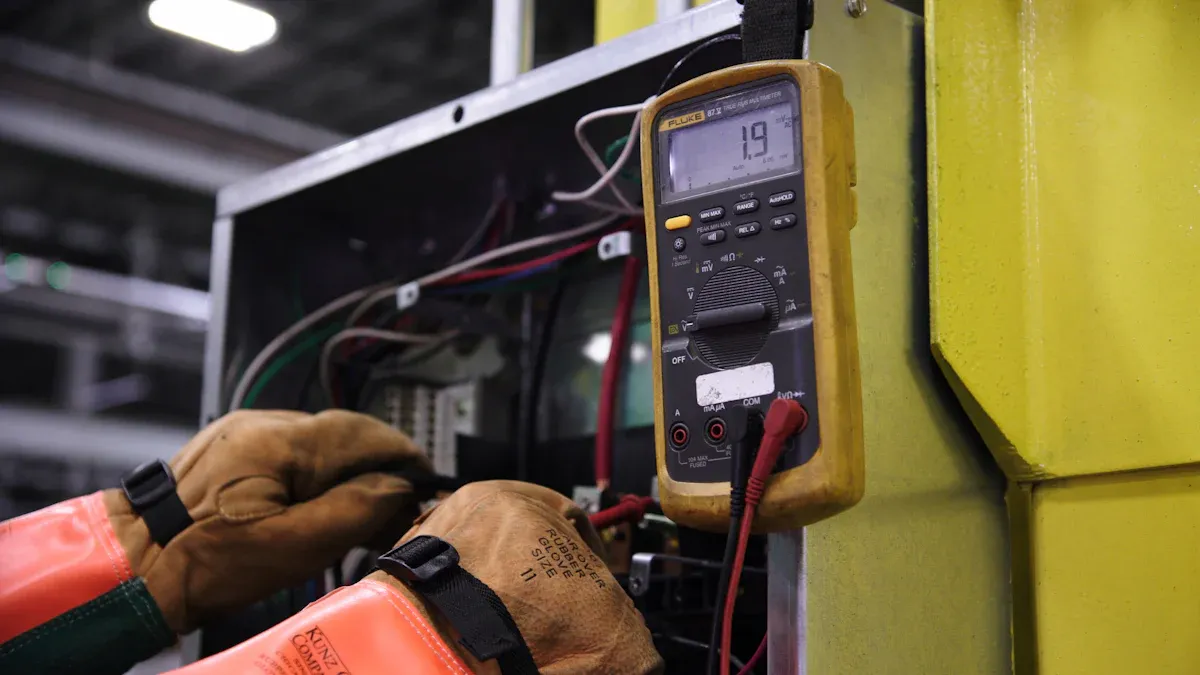You will see DC miniature circuit breaker breaking capacity values like 6kA, 10kA, and even 25kA in product lists. These numbers tell you how much short-circuit current a breaker can safely stop. International standards, like IEC/EN 60898-1, say breaking capacity is the highest symmetrical fault current a breaker can interrupt at its rated voltage. Picking the right breaking capacity keeps your circuits safe and fits your system’s needs.
| Breaking Capacity (kA) | Market Prevalence (%) | Notes |
|---|---|---|
| 6 | ~19-22% | Common for many DC MCBs |
| 10 | ~25-33% | Popular for solar PV and DC uses |
| 25 | N/A | Advanced, used in high-demand renewable setups |
Key Takeaways
- Breaking capacity means the biggest short-circuit current a DC miniature circuit breaker can safely stop. This helps protect your system.
- If you pick a breaker with breaking capacity lower than your system’s fault current, it can cause damage. It may also start a fire or create safety problems.
- Most homes use 6kA breaking capacity. Commercial places use 10kA. Factories or big buildings use 15kA or even more.
- Always make sure the breaker’s voltage, current rating, and breaking capacity fit your system. Check if it meets safety rules.
- Find breakers with thermal magnetic trips and arc extinguishing. These features help the breaker handle high fault currents safely.
DC Miniature Circuit Breaker Breaking Capacity

What Is Breaking Capacity
Breaking capacity shows the biggest short-circuit current a DC miniature circuit breaker can safely stop. If there is a problem, the breaker must quickly stop the electricity without getting damaged. You will find this value in kiloamperes (kA) on the label. For example, a breaker with 10kA breaking capacity can handle up to 10,000 amps of fault current before it might fail. This number is not just a label. It means the breaker will protect your system during dangerous times.
It is important to know that breaking capacity is not the same as current rating. The current rating tells you the normal current the breaker can carry. Breaking capacity tells you the highest fault current it can stop. If you pick a breaker with a breaking capacity lower than the possible fault current, it might not work right.
Why It Matters
You need to pay close attention to breaking capacity when working with DC circuits. DC current only flows one way and does not have zero-crossing points like AC current. This makes it harder to stop the electric arc when a problem happens. The arc can last longer and do more damage. Because of this, DC miniature circuit breakers need higher breaking capacity and special arc-stopping features.
Solar photovoltaic systems and electric vehicles have even bigger risks. These systems often use high voltages and can make large fault currents. If you use a breaker with not enough breaking capacity, you put your equipment and safety in danger. The breaker might not stop the current, which can damage equipment, cause fires, or hurt people. Solar panels and EV batteries need strong protection to avoid expensive problems.
Tip: Always check the highest possible fault current in your system before you pick a breaker. Make sure the DC miniature circuit breaker breaking capacity is equal to or higher than this number.
If you choose a breaker with too low a breaking capacity, you could have these problems:
- The breaker cannot stop the fault current, which can damage equipment or cause a fire.
- The breaker case might crack or break from the arc energy.
- The inside parts might burn or change shape, so the breaker cannot be used again.
- The breaker might trip at the wrong time and stop your power.
- If the breaker is slow to stop the current, it can cause bigger failures or blackouts.
You can avoid these problems by picking a breaking capacity that matches your system’s needs. This helps keep your DC circuits safe, reliable, and working for a long time.
Breaking Capacity Values
Common Ratings
When you look at DC miniature circuit breakers, you will see some usual breaking capacity ratings. Most products show numbers like 6kA, 10kA, and sometimes 25kA. These numbers tell you the biggest fault current the breaker can safely stop. Manufacturers put these ratings on product labels and datasheets. They use kiloamperes (kA) for these ratings. You will also see other details, like rated current, voltage, and insulation voltage, next to the breaking capacity.
Note: The breaking capacity rating shows the highest short-circuit current the breaker can stop without damage. This helps you know if the breaker is safe for your system.
The breaking capacity you need depends on where you use the breaker. Homes often use breakers rated at 6kA. Stores and offices may need 10kA. Factories can need 15kA or more because they have bigger fault currents and heavy machines.
Here is a table that shows common breaking capacity values for different places:
| Installation Type | Typical MCB Type | Breaking Capacity (kA) | Load Characteristics |
|---|---|---|---|
| Residential | Type B | ~6 | Resistive loads, low inrush |
| Commercial | Type C | ~10 | Inductive loads, moderate inrush |
| Industrial | Type D | 15 or more | Heavy inrush, large motors |

Voltage and Current Ranges
You will find DC miniature circuit breakers with voltage ratings from 300V up to 1200V. Many models keep the same breaking capacity at these voltages. For example, Beny and USFULL breakers have a 6kA breaking capacity at 300V, 600V, 900V, and 1200V. This means the breaker can stop the same fault current at any voltage.
| Rated Working Voltage (VDC) | Ultimate Breaking Capacity (Icu) (kA) | Run Breaking Capacity (Ics) (kA) |
|---|---|---|
| 300 | 6 | 6 |
| 600 | 6 | 6 |
| 900 | 6 | 6 |
| 1200 | 6 | 6 |
You can also look at voltage ratings and breaking capacities in this table:
| Voltage Rating (VDC) | Breaking Capacity (Icu) (kA) | Run Breaking Capacity (Ics) (% of Icu) |
|---|---|---|
| 300 | 6 | 100 |
| 600 | 6 | 100 |
| 900 | 6 | 100 |
| 1200 | 6 | 100 |
When you pick a DC miniature circuit breaker, you will see different current ratings. Single-pole breakers usually cover 10A to 125A. Multi-pole breakers, like two-pole, three-pole, or four-pole, can handle higher currents and voltages. Multi-pole models often have higher breaking capacities and work for bigger systems.
Here is a table that shows how current ranges and breaking capacities match pole setups:
| Configuration | Rated Current Range (A) | Voltage (V DC) | Breaking Capacity (kA) |
|---|---|---|---|
| 1P | 10 – 125 | Up to 300 | 6 – 10 |
| 2P | 16 – 250 | 100 – 200 | 6 – 10 |
| 3P | 16 – 63 | Up to 900 | 7.5 |
| 4P | Up to 63 | Up to 1200 | 10 |
You will see that multi-pole breakers are made for higher power and voltage jobs. For example, a four-pole breaker can protect circuits up to 1200V DC with a breaking capacity of 10kA. This makes them good for solar PV arrays and big DC systems.
Tip: Always check both the voltage and current ratings when you pick a breaker. Make sure the DC miniature circuit breaker breaking capacity matches your system’s biggest fault current.
If you look at product series, you will see many rated currents and breaking capacities. Some series, like S800P, support up to 125A and breaking capacities up to 50kA. Others, like S800C, offer up to 63A and 25kA. This lets you choose the right breaker for your job.
| Series | Rated Current Range (A) | Breaking Capacity (kA) | Notes on Pole Configurations |
|---|---|---|---|
| S800P | 80 – 125 | Up to 50 | Good for high breaking capacity |
| S800S | 0.5 – 63 | Up to 50 | Single and multi-pole versions |
| S800N | 6 – 63 | Up to 36 | |
| S800C | 10 – 63 | Up to 25 | |
| S800B | 32 – 63 | Up to 16 |

You can see that DC miniature circuit breaker breaking capacity depends on the breaker’s design, voltage rating, current rating, and pole setup. Manufacturers give you lots of choices so you can match the breaker to your system’s needs.
Factors Affecting Breaking Capacity

Voltage and Fault Current
When you pick a DC miniature circuit breaker, you need to know what affects its breaking capacity. The most important things are system voltage and possible fault current. In DC systems, current does not go to zero. The breaker must stop the full fault current until the arc ends. This can last a few milliseconds or even hundreds of milliseconds. Higher voltage and bigger fault currents put more stress on the breaker’s contacts. If voltage and current go up, you need a breaker with higher breaking capacity. This helps stop the current safely and keeps the breaker from getting damaged.
In big DC projects, like HVDC lines or large solar arrays, fault current can rise very fast. You must pick a breaker that matches the highest fault current in your system. Some advanced breakers use fault current limiters to help control these high currents. If you use a breaker with too low breaking capacity, it might not protect your equipment.
The environment also matters. High temperatures can change when the breaker trips, so you may need to pick a different one. Humidity can cause rust or damage, so look for breakers made to handle these conditions. Some breakers work well from -40°C to +75°C and can handle both dry and wet places.
Note: Always check the voltage, fault current, and environment before you choose a DC miniature circuit breaker.
Standards and Testing
You should pick DC miniature circuit breakers that meet international standards. IEC 60947-2 is a main standard for testing and rating breaking capacity. This standard checks if the breaker can safely stop the rated fault current at the rated voltage. Breakers that meet these standards are safer and more reliable.
High breaking capacity breakers have special features for safety. Thermal trip mechanisms use a bimetallic strip that bends when hot. This trips the breaker during overloads. Magnetic trip mechanisms use an electromagnet to trip the breaker fast during a short circuit. Many breakers use both types for quick and accurate protection.
Arc extinguishing barriers are also important. When the breaker opens, an arc forms between the contacts. The arc extinguishing system puts out this arc fast. This stops the current and keeps the breaker safe from damage. These features help the breaker handle high fault currents and keep your system safe.
Tip: Always check for standards and look for features like thermal magnetic trip mechanisms and arc extinguishing barriers when you pick a breaker.
Selecting the Right DC MCB
Matching to Application
When you pick a DC miniature circuit breaker, it should fit your system. First, find out the biggest short-circuit current your system can make. The breaker’s breaking capacity must be more than this number. This keeps your equipment safe. For example, if your solar PV system can have a fault current of 8kA, pick a breaker rated at least 10kA.
You also need to think about other things:
- The voltage rating must be the same as your system voltage. For example, a 1,000V DC breaker works for a solar PV array with 1,000V.
- The current rating should be a little higher than your system’s biggest load. This stops the breaker from tripping too often but still protects your wires.
- Pick the right pole setup. Use 1P for simple circuits. Use 4P for bigger systems that need full isolation.
- Check if your system needs polar or non-polar breakers. Polar breakers help protect against reverse currents.
- Make sure the breaker can work in your environment. Look for the right temperature range and IP rating for inside or outside use.
- Always check if the breaker meets safety standards like IEC 60947-2 or UL.
Here is a table to help you compare important things:
| Factor | What to Check |
|---|---|
| Rated Voltage (Ue) | Same as system voltage (like 1,000V DC for solar PV) |
| Current Rating (In) | Just above max load (like 25A for 20A load) |
| Breaking Capacity | More than max fault current (like 10kA for 8kA system) |
| Polarity | Polar for protection from reverse current |
| Pole Configuration | 1P, 2P, 3P, 4P for simple or complex systems |
| Environmental | Temperature and IP rating for where you use it |
| Standards Compliance | IEC, UL, or other safety marks |
Practical Tips
You can choose better by following some easy tips:
- Always look at the manufacturer’s datasheet. Check things like breaking capacity, voltage, current, and how long it lasts.
- Look for marks like UL, CE, or CSA. These show the breaker is safe.
- Check how many times the breaker can work. Some breakers last up to 20,000 mechanical cycles and 1,500 electrical cycles.
- Look at the impulse withstand voltage. If it says 4kA, the breaker can handle voltage spikes.
- Pick the right trip curve. Type C works for most loads. Type D is good for big motors or high inrush currents.
- Make sure extra parts, like shunt trips or auxiliary contacts, fit the breaker’s ratings and connections.
- Do not pick a breaker that is too big. A breaker with too high a breaking capacity costs more and may not protect your wires well.
Tip: Always check the breaker’s certification and test results before you install it. This helps you stay safe and makes sure your system is protected.
Picking the right breaking capacity for your DC miniature circuit breaker helps keep your system safe. You need to match the breaker’s rating to the highest fault current in your system. Always follow the rules and standards for safety.
- Breaking capacity tells you the biggest fault current a breaker can stop.
- If you choose the wrong rating, it can cause fires or damage.
- Always look at standards like IEC 60947-2 and check breakers after problems.
- Pick the right breaker type for your place and the kind of load.
Always put safety first and follow the rules when you protect a DC circuit.
FAQ
What does “breaking capacity” mean on a DC MCB?
Breaking capacity is the biggest short-circuit current a DC miniature circuit breaker can safely stop. You will see this number on the breaker’s label. It is usually shown in kiloamperes (kA).
What happens if you use a DC MCB with too low breaking capacity?
If the breaker’s breaking capacity is too low, it might not work during a fault. This could damage equipment, start a fire, or hurt someone. Always pick a breaker with the right rating for your system.
What standards should you check for DC miniature circuit breakers?
Look for standards like IEC 60947-2 or UL. These standards show the breaker passed safety and performance tests. Always check for certification marks on the breaker.
What is the difference between breaking capacity and current rating?
Breaking capacity is the highest fault current the breaker can stop. Current rating is the normal current the breaker can carry without tripping. Both numbers help keep your system safe.
What features help DC MCBs handle high breaking capacity?
Manufacturers add things like thermal magnetic trip mechanisms and arc extinguishing barriers. These features help the breaker stop high fault currents fast and safely.
See also
Understanding the Rated Capacity of Air Circuit Breakers
How to Choose a Solar DC MCB for Maximum Protection
Your checklist for selecting a 200 ampere MCCB in 2025
Understanding DC Miniature Circuit Breakers for Beginners
Circuit Breakers vs Miniature Circuit Breakers: What Sets Them Apart
Understand API 607 and API 608



